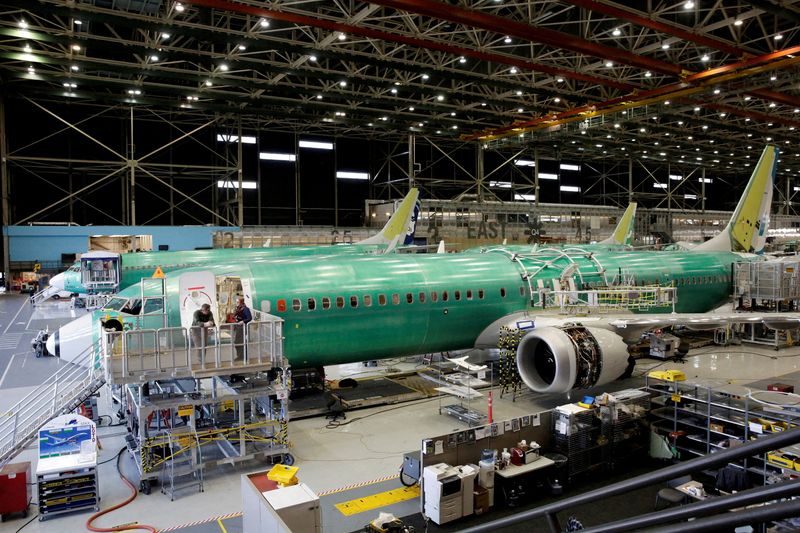
©Reuters. FILE PHOTO: Boeing’s new 737 MAX-9 is pictured under construction at their manufacturing plant in Renton, Washington, U.S., February 13, 2017. REUTERS/Jason Redmond/File Photo
By Valerie Insinna and Abhijith Ganapavaram
(Reuters) – Boeing (NYSE) executives on Wednesday maintained their financial targets for 2025-2026 and said the company was working hard to regain the trust of regulators and customers after the cabin panel blowout in mid-air of a 737 MAX aircraft, lifting its shares 6.1%.
As expected, CEO Dave Calhoun offered no financial or delivery forecast for 2024, saying the company needs to focus on providing quality airplanes.
However, Chief Financial Officer Brian West said during an earnings call that the company remains confident it will achieve free cash flow of about $10 billion and production of 737 of 50 units per month in 2025-2026, as outlined by the company in November 2022.
West added that Boeing expects a stable year of cash flow based on 737 production at its current pace of 38 jets per month, as well as deliveries of 737s and 787s from its inventory.
The crash involving a MAX 9 jet operated by Alaska Airlines this month has turned into a full-blown safety and reputational crisis, potentially leading to a slowdown in jet production and a loss of tighter market share for Airbus.
The US Federal Aviation Administration (FAA) banned the company from halting production earlier this month, while increasing its oversight. On Monday, Boeing withdrew an exemption request to the FAA to speed up certification of its upcoming MAX 7.
Boeing executives declined to set new certification timelines for the MAX 7 and MAX 10, which also has some systems that will need to be redesigned before entering service. However, an “engineering solution” for the MAX 7 could be completed within a year, West said.
Calhoun added that MAX 7 and 10 certification was “progressing reasonably well,” with MAX 7 “near the finish line” until Boeing withdrew its exemption request, which he called “the right thing to do for aviation “.
Despite the production cap imposed on Boeing, executives said it will keep production from its 737 suppliers at the higher rates set in the overall schedule, which calls for an increase to 42 per month in February.
“If that means we have to hold more inventory, so be it,” West said. Calhoun added that the move would give some providers time to catch up with current rate increases.
The plane maker reported a smaller-than-expected quarterly loss as well as better-than-expected revenue and cash flow, although investors are more likely to focus on the company’s expectations as it navigates the current crisis.
Of the 171 MAX 9s grounded by the FAA earlier this month, 129 have returned to service, Calhoun said.
Calhoun told CNBC in an earlier interview Wednesday that he was confident the door-holding problem was completely under control.
He declined to comment on media reports that Boeing did not replace bolts after removing the door plug from the Alaska Airlines jet that suffered the blowout, citing an ongoing investigation by the National Transportation Safety Board, but said which would be an “error” if the NTSB finds that the bolts were not installed.
Robert Stallard of Vertical Research Partners said in a note to investors that the full consequences of MAX’s safety problems have yet to be seen.
Jefferies projects the company could accumulate $5.5 billion in free cash flow in 2024 if it delivers 545 737s and 84 787s during the year, but that projection assumes Boeing is able to increase 737 production to 42 jets per month in the second half.
“GO SLOW TO GO FAST”
Increasing production of 737 MAX jets is critical to Boeing’s recovery from a separate safety crisis stemming from two deadly crashes in 2018 and 2019 and the subsequent aerospace crisis that followed due to the COVID-19 pandemic.
But Calhoun has repeatedly said the company must be willing to slow down if necessary to address quality issues.
“We’re not going to predict the timing. We’re not going to get ahead of our regulator. We’re going to go slow to go fast,” he said.
Boeing has about 200 MAX jets and 60 787 Dreamliners in its inventory, most of which will be delivered this year, West said.
The 787 production pace is five per month, Boeing said, adding that it also resumed production of the 777X during the fourth quarter.
For the fourth quarter, Boeing reported an adjusted loss per share of 47 cents, narrower than analysts’ estimates of a loss of 78 cents, according to LSEG data.
The company’s struggling defense business posted losses of $139 million on fixed-price development programs.
Revenue rose 10% to $22.02 billion, above expectations of about $21.1 billion.
It reported 2023 free cash flow of $4.43 billion, hitting its $3-5 billion target for the year.